The southern seaboard state of Tamil Nadu is the first in the country to officially abandon the conventional mode of teaching/learning in primary education — seven 40-minute periods of instruction per day delivered by single-subject teachers in age-homogeneous classrooms — and adopt ABL in all government primary schools. Hemalatha raghupathi reports
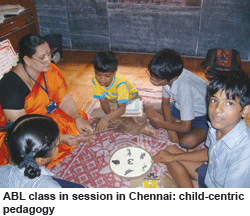 The buzzing classrooms of the Chennai Primary School, Puliyur, are a world apart from conventional state government primaries where teachers talk down to children seated on dented wooden benches set in rows. Here, 30 class I-IV children aged five-nine years sit in mixed groups on colourful reed mats scattered about the classroom, absorbed in a spectrum of activities and worksheets (cards). A variety of learning materials are neatly stacked on shelves while blackboards running the entire lower halves of classroom walls are used by students (not teachers) to practice writing and maths sums. Teachers too sit on the mats with students and guide individual and group activities. A crosswire running across the classroom displays the art and crafts of children.
The buzzing classrooms of the Chennai Primary School, Puliyur, are a world apart from conventional state government primaries where teachers talk down to children seated on dented wooden benches set in rows. Here, 30 class I-IV children aged five-nine years sit in mixed groups on colourful reed mats scattered about the classroom, absorbed in a spectrum of activities and worksheets (cards). A variety of learning materials are neatly stacked on shelves while blackboards running the entire lower halves of classroom walls are used by students (not teachers) to practice writing and maths sums. Teachers too sit on the mats with students and guide individual and group activities. A crosswire running across the classroom displays the art and crafts of children.
Six-year-old Senthil — a class I student — is eager to show off his newly acquired maths skills and demonstrates a subtraction sum using colourful beads. His teacher steps in to help with more difficult problems.
Adjacently, Karthik, a class IV student, reads a Tamil lesson from a worksheet and begins arranging words to construct sentences. They meet with the teacher’s approval and he proceeds to the next level of exercises. Sitting in a larger group, Dakshayini of class III takes a moment off from her worksheet to assist Amudha of class I in reading her English lesson. In the same group, newly enroled Radha (9), who should be in class III, is learning class I lessons.
Senthil, Karthik, Dakshayini, Amudha and Radha are among the 5 million children enroled in Tamil Nadu’s 37,486 government primary schools (class I-V), learning the three R’s through a radical new pedagogy — Activity Based Learning (ABL). Introduced in 2003 in 13 Chennai corporation schools by the DMK government, ABL is now being implemented in all of the state’s 37,486 corporation, panchayat, government and aided primary schools.
The southern seaboard state of Tamil Nadu (pop. 72 million) is the first in the country to officially abandon the conventional mode of teaching/learning in primary education — seven 40-minute periods of instruction per day delivered by single-subject teachers in age-homogeneous classrooms — and adopt ABL in all government primary schools. Designed and tested by the Rishi Valley Rural Education Centre of the pioneer alternative education Rishi Valley School, Chittoor (co-ranked with The Doon School, Dehradun as India’s most respected legacy boarding school in the EducationWorld-C fore India’s Most Respected Schools Survey 2010) in the 1990s, ABL is a child-centric pedagogy which mixes children aged five-nine years in classrooms to encourage activity-led peer learning, and self-study using activity cards and worksheets with teachers discharging the role of facilitators rather than instructors.
.gif) “Over the past decade ABL has revolutionised teaching-learning in Tamil Nadu’s government primaries resulting in significantly improved learning outcomes. Under the conven-tional chalk-n-talk teaching method, 30-40 percent of children couldn’t read or write Tamil fluently and 60-70 percent couldn’t solve basic maths sums even after five years of schooling. Now since ABL has been introduced, there’s been a significant improvement in learning outcomes. With children encouraged to learn at their own pace through enjoyable activities, classrooms have become child-friendly, and student truancy has reduced sharply. Moreover ABL has successfully addressed the problems of multi-grade and multi-level teaching, especially in rural schools which often employ only one or two teachers,” says Dr. M.P. Vijayakumar, an alumnus of Madras, Ambedkar Law and Alagappa univer-sities, former education secretary and currently advisor to the Sarva Shiksha Abhiyan (SSA, Education for All) programme of the Tamil Nadu government.
“Over the past decade ABL has revolutionised teaching-learning in Tamil Nadu’s government primaries resulting in significantly improved learning outcomes. Under the conven-tional chalk-n-talk teaching method, 30-40 percent of children couldn’t read or write Tamil fluently and 60-70 percent couldn’t solve basic maths sums even after five years of schooling. Now since ABL has been introduced, there’s been a significant improvement in learning outcomes. With children encouraged to learn at their own pace through enjoyable activities, classrooms have become child-friendly, and student truancy has reduced sharply. Moreover ABL has successfully addressed the problems of multi-grade and multi-level teaching, especially in rural schools which often employ only one or two teachers,” says Dr. M.P. Vijayakumar, an alumnus of Madras, Ambedkar Law and Alagappa univer-sities, former education secretary and currently advisor to the Sarva Shiksha Abhiyan (SSA, Education for All) programme of the Tamil Nadu government.
A respected bureaucrat who has served in various departments of the state government for over 33 years, Vijayakumar is widely acknow-ledged as the moving force behind the introduction and implementation of ABL in Tamil Nadu. Passionate about reforming public school education for the benefit of poor and underprivileged children, Vijayakumar’s search for an alternative child-friendly pedagogy began in 1994 when as collector of Vellore district, he set up non-formal schools for children working as bonded labour in the area. Given their deprived backgrounds and hard lives, traditional rote-learning pedagogies had little appeal for them. To spark their interest he, together with some colleagues, informally devised an activity-based, interactive and joyful model of learning.
This experiment attracted the attention of teachers from adjoining panchayat schools who expressed interest in adopting them. Subsequently in 1996 when Vijayakumar was appointed additional secretary in the state education department, he roped in SchoolScape, a Chennai-based NGO, to formally train teachers to teach subjects through activity-led, enjoyable lessons. During his four-year tenure as education secretary, 7,000 government primary school teachers were trained, and faculty from the District Institutes of Education and Training (DIET) and staff of Block Resource Centres visited schools in Madhya Pradesh where education NGO Ekalavya was developing similar teaching-learning pedagogies.
The turning point came in 2003 when 30 government primary teachers and supervisory staff underwent a three-month training programme at the Rishi Valley Rural Education Centre (REC), which had designed learning materials based on ABL pedagogy for maths, Telugu and environmental science, and successfully implemented it in neigh-bourhood government schools. REC’s learning materials were adapted to Tamil Nadu with English, Tamil and social science added.
Finally in 2003, Vijayakumar, then commissioner of the Chennai Municipal Corporation, formally launched ABL on an experimental basis in 13 corporation schools, which was later expanded to all 264 corporation schools in the city. Subsequently in 2006, when he took charge as state project director of SSA, Vijayakumar persuaded the DMK government to implement ABL in all 37,486 government primaries including corporation, panchayat and aided schools. The state government dipped into the SSA grant of Rs.700 crore to pay for production of ABL learning materials, study cards and teacher training.
After successfully introducing ABL in government primaries, Vijayakumar shifted his attention to developing a similar pedagogy for middle schools (classes VI-VIII) in the state. He visited The School, Chennai, promoted by the Krishnamurti Foundation India which also runs the Rishi Valley School (RVS), Chittoor, and requested Sumitra M. Gautama, the school’s outreach coordinator, to conduct workshops for middle school teachers on new pedagogies which RVS had developed. These workshops culminated in the development of Active Learning Methodologies (ALM), which are being implemented in the state’s 10,000 government middle schools since 2008.
By common consensus, the pioneer ABL and ALM pedagogies have infused new energy into the state’s languishing primaries. Previously dull and unexciting classrooms where teachers lectured to passive children made to learn by rote, have been miraculously transformed into hubs of activity with pupils using colourful study cards to learn, and all-powerful teachers becoming enabling facilitators. Unattractive, poorly produced and error prone government school textbooks have been replaced by four colour coded cards and worksheets in five subjects — English, Tamil, maths, science and social science. A sixth subject has been added which includes puppetry, storytelling, paper craft, drawing, collage and outdoor games. Each class is compulsorily restricted to a maximum of 30 children and on any given day, only two of the five subjects are studied at length.
According to spokespersons of the growing community of ABL converts, central to ABL is the “learning ladder” with the syllabus divided into small units, each provided with self-learning materials grouped under study cards. When a child finishes with a set of cards, she completes a ‘milestone’ on the ladder and is assessed by the teacher before moving to the next level. Every milestone involves completing several activities including games, rhymes, drawings and songs. Children have to cross 23 milestones in each subject.
Evaluation is inbuilt with teachers constantly assessing each child’s progress, which is recorded in an annual assessment chart. There are no exams but a student cannot move to the next level without attaining competency in the previous one. The pedagogies of peer and self-learning are integral to ABL with children rotated between indi-vidual, teacher-assisted and group-assisted learning, enabling the teacher to pay personal attention and record the achievement level of every child.
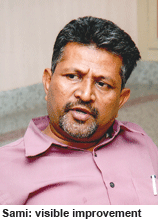 The evidence indicates that the ABL system is working well in Tamil Nadu. A state government-sponsored study conducted in 2008 by NGO School Scape shows an increase of 25-29 percent in children’s competency skills in maths, Tamil and English after the introduction of ABL.
The evidence indicates that the ABL system is working well in Tamil Nadu. A state government-sponsored study conducted in 2008 by NGO School Scape shows an increase of 25-29 percent in children’s competency skills in maths, Tamil and English after the introduction of ABL.
“ABL has visibly improved children’s learning skills and their entire attitude towards school and schooling. In the conventional chalk-n-talk method practiced for the past 150 years, children memorised lessons, mindlessly copying from the blackboard. Now they learn by doing and the system allows for diversity and differing rates of progress among students. ABL has also broken traditional hierarchies and created democratic classrooms where children make independent decisions — from choosing their own activity cards for the day to marking their own attendance cards. Moreover students develop the vital skills of problem solving, self-learning and independent thinking,” says Dr. Bernard D. Sami, associate professor in the department of history and international affairs, Loyola College, Chennai, who through his association with Arunodaya, a city-based NGO, has closely monitored the ABL pedagogy and its implementation in Tamil Nadu.
With ABL receiving support and ringing endorsement from the academic and educationist communities, the state’s 120,000 government primary school teachers, who were initially sceptical about adopting this new pedagogy are beginning to warm to it. The DMK government’s decision — taken in 2006 — to expand ABL to all the 37,000-plus government elementaries aroused considerable resentment, with the state’s seven primary teachers’ unions staging protests and demanding its withdrawal. Several groups of teachers met the then state education minister, Thangam Thennarasu, and made presentations highlighting flaws and inconsistencies of the new pedagogy. This prompted the state government to constitute an expert committee to review the ABL model and suggest improvements. Simultaneously extensive teacher-training workshops were held to familiarise them with ABL and win their support for this path-breaking new teaching-learning methodology.
“Teachers were initially resistant to change since ABL requires them to help children learn through hands-on activities. This is a 360 degree turn from the earlier system in which they lectured and children listened passively. Teaching in new egalitarian classrooms required some unlearning and relearning on the part of teachers. But I’m happy to say that now teachers have fully understood the benefits of ABL and teacher-child relationships have improved dramatically. On our part we motivate teachers by conducting regular workshops and one Saturday in a month, teachers meet in clusters to share their experiences and ideas,” says a senior official of SSA, Tamil Nadu.
Undoubtedly this revolutionary pedagogical reform in India’s crumbling government school system governed by self-serving politicians and indifferent bureaucrats is a praiseworthy achieve-ment, and Tamil Nadu’s ABL success story has attracted the attention of the Central as well as state governments countrywide. Since 2008, a steady flow of educationists from 18 states of the Indian Union have been visiting government primary schools in Tamil Nadu to study the implementation of ABL and its adaptability. Moreover, representatives from the Tamil Nadu state education department have also been touring India and sharing ABL know-how with contemporaries in other states. In July 2010, when Union human resources development minister Kapil Sibal visited government primary schools in Chennai and Trichy, he was bowled over by ABL-powered class-rooms, and particularly the children’s enthusiasm and ability to read and write. “There is real democracy in the classroom. This needs to be emulated by other states,” opined Sibal.
Encomiums for the ABL system are also pouring in from beyond national borders. Experts from the World Bank and European Commission who visited Tamil Nadu in August 2008 praised the DMK government for scaling up the project to all government and aided primary schools statewide. Moreover, teams of educationists from Sri Lanka, Malaysia, Singapore, the Netherlands, China and Bangladesh have also visited the state in recent years to study how ABL can be adapted to their primary curriculums.
Within the country, the state govern-ments of Andhra Pradesh, Rajasthan, Chhattisgarh and Puducherry have introduced ABL in classes I-II on a pilot basis in select government schools with Madhya Pradesh, Nagaland, Tripura, Mizoram, Arunachal Pradesh, Himachal Pradesh, and Jharkhand planning to introduce it next year. In Tamil Nadu’s neighbouring state of Karnataka (pop. 59 million), ABL — rechristened Nali Kali (‘joyful learning’) — was introduced way back in the 1990s on a pilot basis in a handful of government primaries in Mysore district. In 1995, a group of 15 teachers and administrators from H.D. Kote — a remote tribal block in Mysore district — visited the Rishi Valley Rural Education Centre to study the ABL pedagogy developed by it, and subsequently with the help of Unicef adapted it to H.D. Kote’s government primaries, simultaneously rechristening it.
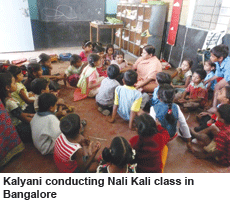 With Nali Kali working well in the tribal block, the Karnataka government decided to expand it to all public primaries in the Mysore rural district in 1997. However, after this initial burst of enthusiasm, the state’s education bureaucrats mysteriously lost all interest in the programme until 2009, when a sudden decision was taken to extend it to 13,691 government primaries statewide. In the academic year 2010-11, it was extended to all 23,690 government and aided primaries in classes I-III.
With Nali Kali working well in the tribal block, the Karnataka government decided to expand it to all public primaries in the Mysore rural district in 1997. However, after this initial burst of enthusiasm, the state’s education bureaucrats mysteriously lost all interest in the programme until 2009, when a sudden decision was taken to extend it to 13,691 government primaries statewide. In the academic year 2010-11, it was extended to all 23,690 government and aided primaries in classes I-III.
Inevitably, as in tamil nadu when the new pedagogies were introduced in 2006, the switch to Nali Kali in Karnataka’s government primaries has aroused teacher resistance. Comments T.J. Kalyani, mathematics teacher of the Kannada-medium government primary school in S.R. Nagar, Bangalore: “Children learn better in Nali Kali but under this system, teachers have to constantly monitor students working in groups, provide individual attention to all of them and also maintain a record of their continuous progress. Moreover it’s very difficult for us to manage children of classes I-III aggregated into one classroom.”
Following the Tamil Nadu precedent, the BJP-led government in Karnataka has initiated a series of teacher training workshops, provided teachers with Nali Kali learning kits and deployed SSA officers to visit primary schools every fortnight to monitor effective delivery of the programme. “We need to convince teachers about the efficacy of the Nali Kali programme and motivate them to embrace it. Right now our focus is on successful implementation of the system in classes I-III which requires upgrading of learning materials, preparing study cards, and training teachers to teach mixed age groups effectively. But in the long run, if we want the programme to succeed we must reduce pupil-teacher ratios by appointing more teachers. Moreover teacher education and training has to be a sustained and continuous process,” says B. Bhemanna, senior programme officer of the Nali Kali project in Karnataka.
In neighbouring Maharashtra (pop. 112 million), the state government is tentatively planning to implement ABL in 75,000 government-run primaries. In March 2007, the state government introduced ABL on a pilot basis in its primaries in Nandadeep in Latur district, later extending it to all local government primaries in the district. But since then it has failed to roll it out statewide. Reason: the Maharashtra State Council of Educational Research and Training is yet to finalise and adapt its primary curriculum to ABL. However, a broadly similar initiative known as School Excellence Programme was introduced by Ashish Kumar Singh, currently secretary to the Maharashtra chief minister, when he was assistant commissioner of Mumbai Municipal Corporation (MMC) during September 2009-November 2010. Funded by Unicef, the programme is now being piloted in 100 MMC schools.
“Several activity-based teaching-learning experiments have been initiated in the state’s government primaries over the past few years, but implementation has been piecemeal. This is because we have not been able to follow it up with intensive teacher training, adapt the textbook curriculum to new learning materials and study cards, and reduce high teacher-pupil ratios in classrooms. ABL requires a complete change in teacher mindsets and is heavily dependent on their ability to effectively monitor and guide children to use creative learning materials. Also switching to new practices requires extraordinary commitment on the part of the government, which is lacking,” says Farida Lambay, vice principal, College of Social Work, Nirmala Niketan, Mumbai and co-founder and trustee of education NGO Pratham.
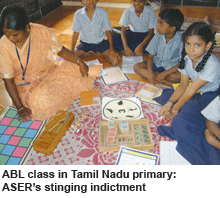 Meanwhile though ABL is now widely accepted and endorsed by educationists and academics as a superior, child-centric, hands-on and joyful pedagogy for primary children, particularly first generation learners, claims that it has significantly improved student learning outcomes in Tamil Nadu’s primary schools are being disputed. A survey conducted by Delhi-based education consultants Subir Shukla and Chennai-based R.Akila in 2009 covering 1,832 government and aided primary and upper primary schools in Tamil Nadu’s 33 districts indicates that only 22 percent of students have attained age-appropriate learning outcomes. According to the survey, 33 and 29 percent of class III children have completed six-ten miles-tones in maths and Tamil respectively, while only 26 percent have been able to do so in English. Consequently as children move to class IV, a large number of them will still be completing their backlog of lessons in all subjects, particularly English, rather than learning new lessons.
Meanwhile though ABL is now widely accepted and endorsed by educationists and academics as a superior, child-centric, hands-on and joyful pedagogy for primary children, particularly first generation learners, claims that it has significantly improved student learning outcomes in Tamil Nadu’s primary schools are being disputed. A survey conducted by Delhi-based education consultants Subir Shukla and Chennai-based R.Akila in 2009 covering 1,832 government and aided primary and upper primary schools in Tamil Nadu’s 33 districts indicates that only 22 percent of students have attained age-appropriate learning outcomes. According to the survey, 33 and 29 percent of class III children have completed six-ten miles-tones in maths and Tamil respectively, while only 26 percent have been able to do so in English. Consequently as children move to class IV, a large number of them will still be completing their backlog of lessons in all subjects, particularly English, rather than learning new lessons.
 “When we conducted this survey in 2009, we found that the ABL methodology didn’t sufficiently challenge children and the prescribed activities were being mechanically carried out by them. The curriculums were not rigorous and children’s application skills were under-developed. Moreover, we found that teachers did not think beyond what they had been instructed which prevented them from raising the bar and giving below-average children individual attention. Learning materials were also not being used for performing multiple tasks. Since our survey, these lacunae are being addressed by education officials and teachers. In the past two years teachers with the help of experts, have been enhancing the curriculum, upgrading textual content, improving the learning ladder and introducing bilingual audiotapes and DVDs for students to improve their English speaking and listening skills,” acknowledges Subir Shukla, National Quality Advisor to the government of India.
“When we conducted this survey in 2009, we found that the ABL methodology didn’t sufficiently challenge children and the prescribed activities were being mechanically carried out by them. The curriculums were not rigorous and children’s application skills were under-developed. Moreover, we found that teachers did not think beyond what they had been instructed which prevented them from raising the bar and giving below-average children individual attention. Learning materials were also not being used for performing multiple tasks. Since our survey, these lacunae are being addressed by education officials and teachers. In the past two years teachers with the help of experts, have been enhancing the curriculum, upgrading textual content, improving the learning ladder and introducing bilingual audiotapes and DVDs for students to improve their English speaking and listening skills,” acknowledges Subir Shukla, National Quality Advisor to the government of India.
In Shukla’s opinion, it’s too early to pass judgement on the efficacy of ABL since it’s been fully implemented only in 2007, with the pedagogy still evolving. “The implementation of ABL on such a large scale in Tamil Nadu is commendable. But it’s too soon to proclaim it an unqualified success. Nevertheless, after ABL was introduced there has been remarkable improvement in children’s confidence levels, communication skills, interaction with teachers and their ability to understand concepts,” admits Shukla.
But while Shukla is willing to suspend judgement on the system’s efficacy in primary classrooms, the Annual Status of Education Report (ASER) 2010, published by Mumbai-based education NGO Pratham, is unsparing. According to ASER 2010, 69 percent of class V children in Tamil Nadu’s rural primaries cannot read class II texts (cf. the national average of 46.6 percent) and 80 percent of class III children can’t manage class I texts. Worse, according to the latest ASER survey compiled by 20,000 volunteers who visited 13,000 rural primaries in 522 districts countrywide, in Tamil Nadu which is widely reputed for its maths geniuses, 85 percent of class V children are unable to do simple division sums (cf. 64 percent nationally).
Quite obviously stung by this devastating indictment of the ABL programme — which is now taught in all rural primaries in Tamil Nadu — education bureaucrats accuse Pratham and ASER surveys of bias. “Pratham conducts an annual survey of student learning achievement in rural primaries across the country and also runs remedial programmes in primary schools in partnership with several state govern-ments. In Punjab and Chhattisgarh where Pratham conducts remedial programmes, learning outcomes have improved dramatically, according to ASER 2010. Moreover most volunteers employed by Pratham to test children are untrained and cannot do full justice to teaching,” says M.P. Vijayakumar, who draws attention to a study conducted by Chennai-based SchoolScape (2007-08), assessing the learning outcomes of children before and after the introduction of ABL which shows a 25-29 percent improvement in children’s maths, Tamil and English competencies.
However Madhav Chavan, the straight-talking chief executive of the highly respected Pratham, doesn’t give much weightage to the SchoolScape study. According to him, this study has measured the learning outcomes of only one batch of students at the beginning and end of the year in which ABL was introduced. “An improvement of 20-30 percent in learning outcomes over one academic year is also observed by ASER. But the same difference was observed before and after ABL was introduced. The point is whether ABL has improved learning outcomes. There is no evidence of that. On the other hand, ASER measures learning levels in each class year after year and sees no change. The ASER Centre is willing to share its methodology and process with the Tamil Nadu government, but the government is resistant to any external independent agency evaluating its schools,” Chavan told EducationWorld (see ‘ASER 2010: Shocking primary learning report card’, EW March 2010).
Contradictory reports of various organisations measuring learning outcomes in the state’s govern-ment primaries have created confusion about the efficacy of the ABL programme. A national mid-term achievement survey of class III children conducted by the Delhi-based National Council for Educational Research and Training (NCERT) in 2008 covering 86,112 children in 7,341 schools in 259 districts across 32 states and Union territories ranked Tamil Nadu first countrywide in mathematics, language and reading comprehension skills. In maths learning too, Tamil Nadu has emerged the best performing state (75.2 percent) followed by West Bengal (69.79 percent).
Though the expertise and credibility of Pratham — an independent globally respected NGO — is by far greater than of the government funded NCERT or School-Scape, all three surveys have served the useful purpose of focusing attention on the lacunae of the ABL learning system and means of addressing them. The consensus among independent educationists and education NGOs in Tamil Nadu is that the ABL pedagogy needs to be tweaked to promote academic rigour and continuous testing and assessment of students.
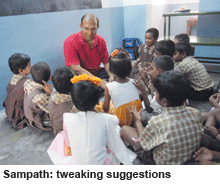 “Currently under the ABL system, insufficient attention is paid to children lagging behind and the complex learning ladder diverts teachers’ attention from ensuring that reading and maths skills of all children are developed. Teachers only track activity cards completed by children without assessing the skills they should have learnt. This must change. Teachers have to get more involved in the learning process, set children rigorous learning goals and assess them continuously. The final purpose should be to ensure that children develop the competencies required in primary education,” says Balaji Sampath, director of AID India, a Chennai-based NGO established in 1997.
“Currently under the ABL system, insufficient attention is paid to children lagging behind and the complex learning ladder diverts teachers’ attention from ensuring that reading and maths skills of all children are developed. Teachers only track activity cards completed by children without assessing the skills they should have learnt. This must change. Teachers have to get more involved in the learning process, set children rigorous learning goals and assess them continuously. The final purpose should be to ensure that children develop the competencies required in primary education,” says Balaji Sampath, director of AID India, a Chennai-based NGO established in 1997.
M.P. Vijayakumar, the visionary SSA advisor to the TN government who has emerged as the champion of ABL during the past decade, concedes that it is an evolving system with the education department, teachers and experts constantly brain-storming to improve it. “Just three years into its full implementation, we have already revised the curriculum, added new learning materials, and updated teacher training manuals. Despite this, there’s considerable scope for improvement. Nevertheless I am fully convinced that Tamil Nadu’s ABL system has provided a joyful learning environment for primary school children in the state. But at the same time we accept the need for continuous improvement of this pedagogy to ensure its success in the cause of upgrading teaching-learning standards in govern-ment schools countrywide,” he says.
Even as flaws are being ironed out, Tamil Nadu’s ABL revolution is a lesson in how political will driven by public opinion can transform indifferent government primary schools into fun-filled hubs of learning where children participate, question and learn rather than passively receive knowledge. It’s a model that needs to be adapted and replicated by all state governments.
With Summiya Yasmeen & Swati Roy (Bangalore) & Manas Shrivastava (Mumbai)